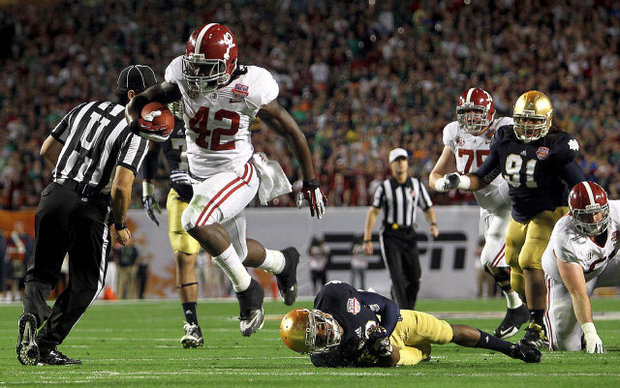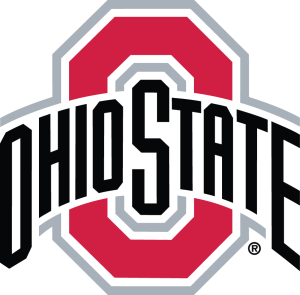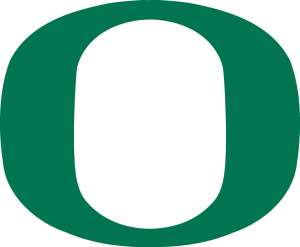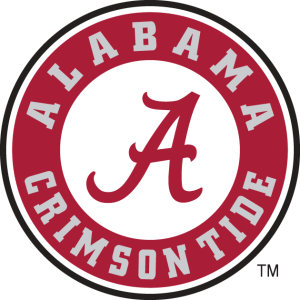College Football’s Top 5 Brands
College football is a big-time player in the American sports scene, with billions of dollars spent and millions of fans heading to the stadium each weekend. With this enormous influence in our sports culture comes the emergence once again of brands who rival the biggest corporations in the world in terms of their brand equity.
With this list, I attempt to rank the top five brands in college football today – and as with any list, there is sure to be some friendly disagreement on who is on the list, where they are ranked and who I snubbed. I looked at the brands who are the first to come to mind when thinking of the sport in general, for whatever reason – and those reasons were varied.
One constant that is seen throughout this list is a high level of on-field success – in fact, there are a combined 45 national championships and over 4,000 all-time wins claimed by the schools on this list. While wins and losses alone don’t determine a strong brand, success does bring an ease to the branding process – people want to associate with winning teams, and they have more attachment to the overall brand when they come out on top more often than not.
However, winning was not the only factor in determining brand strength, but it was a benefit for those brands who have experienced more wins that losses throughout their histories.
The gold helmets. Touchdown Jesus. Notre Dame Stadium. The list of iconic brand elements could go on for the Irish, and that doesn’t even include the millions of fans around the world (and the millions of those who root against the team).
Notre Dame’s branding efforts correctly center on their many traditional and well-recognized aspects, which provide a link to their successful past (11 national championships and a record seven Heisman trophy winners), and proof of their relevance across cultural and generational bounds. No matter their record, interest in Notre Dame remains at the top of the list, as does their brand.
According to a recent report, Ohio State’s football program is worth over $1 billion, which is far and away the most valuable program in the nation. This brand valuation is a key force in driving the strength of their overall brand, providing a wealth (pun intended) of exposure, top-rate facilities, opening new revenue streams and allowing the school to put monetary support behind the football brand strategies necessary to keep them at the top.
They are the flagship school in a football-crazed state and an alumni base that crosses the globe, helping expand the brand equity outside of the Buckeye State borders. The combination of outstanding monetary support and brand awareness with the spoils that come with being the defending national champion have helped the Ohio State brand continue to excel.
At the opposite end of the spectrum of brand strategy from Notre Dame is the University of Oregon Ducks. Where they lack in years of success and iconic brand symbols they make up for in and instantly recognizable visual brand portfolio.
Oregon is capitalizing on their strong visual branding elements to build their brand strategy about how they look – completely with a full set of flashy uniforms that seem to change every week. They highlight their visual elements in all aspect of their brand strategy, from recruiting to marketing to the game day experience.
Alabama is one of the top representations of the power of brand advocates. Located in a state with no professional sports teams but a love of college football that is almost unsurpassed in the entire nation, Alabama has built a loyal fan base that carries its brand near the top of any rankings.
Despite their recent dominance, there were some stretches where the on-the-field product wasn’t top notch, but the loyalty of their brand fans did not waver, showing how strong the brand has ingrained itself in the people in their fan base.
When the three-lettered abbreviation for your school name carries as much verbal branding weight as any other full-named team in the country, that’s not a bad place to start when describing the strength of your brand.
The University of Southern California – USC – has long carried the torch for the west coast in the college football world. They have about as close to the perfect ingredients for the perfect brand as one school can get, where they can pull from years of success on the field, an idyllic location in the heart of Los Angeles, a famous logo and color scheme, prominent alumni and many more.
Image Sources
All Logos
Featured Image
Addison Whitney is a global branding firm with a passion for building strong brands.
To learn more about Addison Whitney, visit our website at AddisonWhitney.com, or contact us here.
Brands Find Ways to Reinvent Themselves for Foreign Markets
There’s always been a mystery associated with foreign brands, but some have found ways to use their homegrown origins to give themselves a completely different brand image in foreign countries.
When Americans think of a nice beer, a wide range of local craft beers or major brands may come to mind, but one that is rarely considered is Pabst Blue Ribbon. This beer may be an American icon, but, ranking as one of the cheapest beers in the country, it is certainly not an American luxury.
However, this is not the case in China. Pabst Blue Ribbon has taken its authentic reputation as an American Icon and repositioned itself in Asian markets as a luxury beer. To an American who ha s never paid more than a dollar for a can of PBR, this may seem ridiculous. However, American exports often already connote luxury and high price point, so by emphasizing its American roots, PBR was able to ride on the wave of other authentically luxury exports from the United States.
s never paid more than a dollar for a can of PBR, this may seem ridiculous. However, American exports often already connote luxury and high price point, so by emphasizing its American roots, PBR was able to ride on the wave of other authentically luxury exports from the United States.
Pabst Blue Ribbon in China is sold in glass bottles, and the ribbon icon, while still maintained, is emblazoned on the bottle in gold rather than the standard blue. Pabst Blue Ribbon in Asian markets is also branded as “1844,” the year that is printed in small type on the traditional blue ribbon in the U.S.
Pabst Blue Ribbon isn’t the only company that has made a deliberate decision to change their brand image and positioning abroad, however.
General Motors has been met with massive success in Asian markets by branding their cars as the epitome of sturdy American dependability. This is another example of a  company modeling the image of their brand around values and characteristics already associated with America such as dependability and strength. Also, Pizza Hut, the quintessential American pizza joint, is a luxury dinner destination in China. The picture to the left shows the interior of a Pizza Hut in China. The Pizza Huts of China serve pizzas in cast iron skillets and offer elaborate fruit towers for dessert.
company modeling the image of their brand around values and characteristics already associated with America such as dependability and strength. Also, Pizza Hut, the quintessential American pizza joint, is a luxury dinner destination in China. The picture to the left shows the interior of a Pizza Hut in China. The Pizza Huts of China serve pizzas in cast iron skillets and offer elaborate fruit towers for dessert.
Branding Pizza Hut, PBR, and General Motors as quality, luxurious American exports may seem like a interesting practice to Americans, but American brands are not the only companies who deploy different brand images based on country. Heineken, for example, is the equivalent of PBR in the Netherlands, its country of origin. In the United States, however, Heineken is viewed as a quality beer.
This demonstrates that no domestic market is immune to the allure and mystique that are often attached to foreign brands, aspects which can help companies a with poor, or cheap, brand image at home reinvent themselves abroad.
Image Sources:
https://www.newyorker.com/news/letter-from-china/pardon-me-would-you-have-any-pabst-blue-ribbon
https://www.globalpartnersmba.com/real-chinese-food/
Addison Whitney is a global branding firm with a passion for building strong brands.
To learn more about Addison Whitney, visit our website at AddisonWhitney.com, or contact us here.
AW in Review: Addison Whitney Brand Salsa Recap 8.28.15
Welcome to another edition of "AW in Review", our roundup of our latest brand salsa and Addison Whitney news and posts!
Don’t forget, you can stay up-to-date with everything from Addison Whitney by joining the conversation with us on our social media channels – Twitter, Facebook, LinkedIn and Google+
New Traditions: The Trend of "Southern" Brands
Popular brands like Southern Proper, Southern Tide and Southern Marsh market themselves with a combination of a sense of heritage and a distinctly southern n character to appeal to the collegiate and young professional market.
n character to appeal to the collegiate and young professional market.
This strategy has proven extremely successful, and these brands have become ubiquitous on college campuses and in post-grad life throughout the southeast. Read More...
Luxury Brands Leading the Way in Social Media Branding
Brands are taking full advantage of the benefits in engaging with their audience on social media, and these efforts are led by a number of luxury brands, according to a  recent report by Shareablee, a social analytics company.
recent report by Shareablee, a social analytics company.
For a brand, this connection with their audience and subsequent positive audience opinion goes a long way in staying among the crème de la crème of brands, a characteristic which in itself can propel a company to success. Read More...
Gaining Brand Trust in a Share Economy
The success of the share economy lies in how its brands cultivate trust.
These brands focus their efforts on making consumers feel that they are interacting with people they can get to know, even if it is through the relative anonymity of the Internet. Read More...
4 Ways Brands Can Top the Class in Back-to-School Branding
 The days are getting shorter, there’s a chill in the air (at least for some of us) and football is back on the TV. That can mean one thing – be ready for the return of school buses during your morning commute and a flood of back-to-school ads coming your way.
The days are getting shorter, there’s a chill in the air (at least for some of us) and football is back on the TV. That can mean one thing – be ready for the return of school buses during your morning commute and a flood of back-to-school ads coming your way.
So, sharpen your pencils – here are four examples of how various brands can get an A+ in back-to-school branding. Read More...
Addison Whitney is a global branding firm with a passion for building strong brands.
To learn more about Addison Whitney, visit our website at AddisonWhitney.com, or contact us here.
4 Ways Brands Can Top the Class in Back-to-School Branding
The days are getting shorter, there’s a chill in the air (at least for some of us) and football is back on the TV. That can mean one thing – be ready for the return of school buses during your morning  commute and a flood of back-to-school ads coming your way.
commute and a flood of back-to-school ads coming your way.
Back-to-school marketing and branding have graduated (it wouldn’t be right to not throw in a few school references) to big-time status in recent years. What used to consist mostly of stores putting their lunch boxes and notebooks on sale has turned into a major opportunity for companies to brand an entire time of the year.
The numbers speak for themselves – according to a recent report, in 2014 alone, back-to-school spending reached nearly $75 billion, with an average per-family spending for K-12 students coming in at $669.29. With that type of consumer activity and the area for opportunity that exists for brands to become a part of the experience, a strong branding strategy should be the first lesson for brands.
So, sharpen your pencils - here are four examples of how various brands can get an A+ (the last one, I promise) in back-to-school branding:
- Let Your Strengths Shine. For some brands, this time of year is ideal for reaffirming an already strong brand position. For brands like Elmer’s Glue, Bic and Crayola, the knowledge that consumers will instantly recognize their brand when doing their back-to-school shopping allows them to bypass the normal starter brand strategies and focus on highlighting their timeless products and classic brand characteristics. Among the mass of available supplies lining the store shelves, even the smallest brand equity can go a long way
- Stand Out from the Crowd. When it comes to brands that are looking to make a mark in this space but don’t have the built-in recognition needed to put their product branding at the forefront, the focus should their brand strategy around their uniqueness and differentiating qualities. Whether it is a new technology or a standout design, figure out how to make the consumer pause on your brand when scanning the shelves.
- Know Your Audience. Not every student is the same, and neither is every consumer situation. For brands, cutting through the clutter and giving their brand messaging a chance to succeed is driven first and foremost by knowing to whom they are speaking. Is your brand one that resonates with college students? Then highlight how the brand can help that make the dorm room shine. Is your fan a hit among kindergarteners? Brand yourself to speak to them and their parents, who will be making most of the buying decisions.
- Capture the Spirit of the Season. Back-to-school is full of hope, anticipation and excitement. Make sure your brand strategy fits these emotions. While the inevitable end of summer can be a sad proposition for a child, the chance for a new year and new adventures is what is going to drive their excitement about school – and if a brand is positioned correctly, their excitement about that brand.
Image Source
https://englishlanding.parkhill.k12.mo.us/cms/One.aspx?portalId=551269&pageId=3967745
Addison Whitney is a global branding firm with a passion for building strong brands.
To learn more about Addison Whitney, visit our website at AddisonWhitney.com, or contact us here.
Gaining Brand Trust in a Share Economy
Today's post comes from guest blogger Caroline Lewis, Brand Strategy Intern at Addison Whitney
In the next 24 hours, nearly 1 million people around the globe will get in a stranger’s personal car using Uber. Over 800,000 will rent accommodations from private individuals with the help of Airbnb. Another 10,000 will lease a place for their pets to stay in someone’s home through DogVacay, and 10,000 more will hand their car keys over to an unfamiliar person using the car-sharing service, RelayRides.
Facilitated by smart phones and the internet, trusting consumers and the companies they use are considered part of the rapidly-growing “share economy,” which offers individuals the ability to exchange resources in a manner that would have been considered foolhardy just a few years ago.
The big question is: why are people placing so much trust in strangers?
This shift in consumer behavior is not caused by a business model trend, but a transformation of our society in the digital age. The economic effects of the global financial crisis of the 2000s have collided with the rise of social media, creating a culture in which we are not only driven by a desire to capitalize on unused resources, but also more open to the idea of sharing, even with complete strangers. This change has fueled an industry in which transactions rely on mutual trust and the exchanging of resources in a manner that benefits the common good.
The success of the share economy lies in how its brands cultivate trust. These brands focus their efforts on making consumers feel that they are interacting with people they can get to know, even if it is through the relative anonymity of the Internet.
Customer comments and ratings dominate web pages, creating atmospheres of credibility and trust between consumers and the brands. Many companies, such as Lyft (a transportation service similar to Uber), Airbnb, and RelayRides, recommend that users offering services connect their accounts to social media. Social media profiles reflect, at least in part, our real identities, and are therefore instrumental in building a more human persona, a strength for any brand.
The result has not only catapulted brands in the share economy space to booming success, but also changed the way that we view the strangers we interact with. Consumers are aware that they are  collaborating with real, individual people, creating a connection between brand, representative, and consumer unique to the share economy.
collaborating with real, individual people, creating a connection between brand, representative, and consumer unique to the share economy.
An Uber driver differs very little from a taxi driver in that both arrive to simply transport you to your destination. However, Uber’s consumers generally report feeling safer and more comfortable, and they are more likely to talk with drivers and sit in the front seat (or dance and sing with the driver, as seen here). With RelayRides, renters must meet the car owner to receive their keys. When RelayRides implemented this policy, satisfaction increased 40%, and users were more likely to keep the cars clean and return them on time. Interactions are between familiar faces, not complete strangers, and are beneficial to the brands, companies and individuals involved.
What does this mean for your brand?
Big or small, trust is essential. Consumers and customers are looking for innovative ways to get things done and want to trust the source – we see it in the share economy business trend, garden-to-table food trend, and home-schooling education trend. Build trust with your audience. Share feedback openly, let consumers get to know your brand ambassadors, salespeople, and customer service representatives in a real way. Let consumers be a part of the brand.
Image sources:
https://www.nytimes.com/2012/12/03/technology/app-maker-uber-hits-regulatory-snarl.html?_r=0
https://www.foxnews.com/travel/2015/04/22/10-things-need-to-know-about-airbnb-before-book/
Addison Whitney is a global branding firm with a passion for building strong brands.
To learn more about Addison Whitney, visit our website at AddisonWhitney.com, or contact us here.
Luxury Brands Leading the Way in Social Media Branding
Brands are taking full advantage of the benefits in engaging with their audience on social media, and these efforts are led by a number of luxury brands, according to a recent report by Shareablee, a social analytics company.
After analyzing over 100,000 brands and 600 million interactions, the brands that stood out included some of the most well-known in the fashion and automotive world, including Mercedes-Benz, who took the top spot and was followed in second by BMW. The fashion world rounded out the top five with Valentino, Michael Kors and Victoria Beckham all finding success in the social media realm.
who took the top spot and was followed in second by BMW. The fashion world rounded out the top five with Valentino, Michael Kors and Victoria Beckham all finding success in the social media realm.
That these brands are finding most of their successes on the more visually-based platforms should come as no surprise. The strong suits of these brands lie in their visually appealing products, speaking to a number of their brand characteristics that carry weight and recognition when seen.
This is shown in the report where the average number of brand followers on Instagram increased nearly 250 percent – these brands are taking advantage of the mainly image-driven platform that Instagram provides and showing off their products and visual aspects of their brand personas.
Additionally, social media provides these luxury brands with the opportunity to connect to a broader audience than they have potential consumers – to follow BMW on Twitter or “like” Michael Kors on Facebook doesn’t cost a penny, so although a consumer may not be in the market for one of their products, a social media engagement can still be a feasible way to connect the consumer to the brand, which is especially powerful when that brand’s persona is one that is aspirational for the consumers, like BMW, who has a high-class connotation among its fans.
From a branding perspective, this connection is vital to maintain their hard-earned brand equity, which is one of the main factors to maintaining their status among the luxury brands. Without the influence in the online and social media realms, and without the ability to market to the masses, these brands would see a serious drop in their ability to compete on the global market.
For example, take Christian Louboutin, the #6 company on Shareablee’s list. The luxury shoe designer has a brand that is respected the world over for its products, but many of its fans are likely unable to afford to purchase anything from the designer’s line. However, they can still feel the connection through social media, which drives positive brand connotations among this same audience.
For a brand, this connection with their audience and subsequent positive audience opinion goes a long way in staying among the crème de la crème of brands, a characteristic which in itself can propel a company to success.
Image Sources:
https://us.christianlouboutin.com/us_en/LouboutinWorld#opi2240509114
https://www.adweek.com/socialtimes/report-fashion-and-automotive-brands-dominate-social-media/624319
Addison Whitney is a global branding firm with a passion for building strong brands.
To learn more about Addison Whitney, visit our website at AddisonWhitney.com, or contact us here.
New Traditions: The Trend of “Southern” Brands
Today's post comes from guest blogger Drew Maurer, Verbal Branding Intern at Addison Whitney
“Modern. Southern. Style.” This is the tagline for southern retail giant Belk, which could also easily describe a score of the men’s clothing manufacturers (many of whom have the word “Southern” in their names) sold within Belk stores.
Popular brands like Southern Proper, Southern Tide and Southern Marsh market themselves with a combination of a sense of heritage and a distinctly southern character to appeal to the collegiate and young professional market. This strategy has proven extremely successful, and these brands have become ubiquitous on college campuses and in post-grad life throughout the southeast.
One of the key strategies these brands have used to become successful is the way they’ve incorporated this aspect of their names throughout their brands to create distinct brand identities that resonate with consumers. The sense of southern identity and heritage embodied in the brand names extends throughout the brand identities.
For example, Southern Proper, a company that started out selling ties and caters specifically to the collegiate market, appeals to “history and heritage” throughout its brand literature, and brands its styles of ties with the names “beaus” and “gents.” They show how to take the ideals embodied by a brand name and extend them throughout the rest of the brand and product line to create a unified brand identity.
brands its styles of ties with the names “beaus” and “gents.” They show how to take the ideals embodied by a brand name and extend them throughout the rest of the brand and product line to create a unified brand identity.
Similarly, Southern Tide, who is also oriented towards a younger, collegiate demographic, describes its founding principles as “craftsmanship, clean lines, classic designs, and rich heritage” and  calls its flagship polo shirt the Skipjack. The company successfully leveraged this name into a coherent and consistent brand identity branding all their products with the distinctive skipjack logo, and appealing to the freedom of the ocean and “an affection for the coast” in their brand identity language, tying their product names, brand name, and company ethos together.
calls its flagship polo shirt the Skipjack. The company successfully leveraged this name into a coherent and consistent brand identity branding all their products with the distinctive skipjack logo, and appealing to the freedom of the ocean and “an affection for the coast” in their brand identity language, tying their product names, brand name, and company ethos together.
Southern Marsh, another brand that has built its brand identity around an evocative name and sense of southern heritage, appeals more directly to a certain 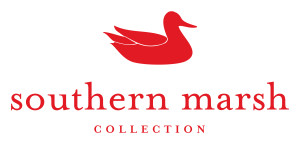 sense of leisure and comfort. On their website they characterize the Southern Marsh wearer as someone who wants to “escape the hustle and bustle of city life” and describes their customers as “the friends getting up at 4 a.m. to make it to the blind before sunrise.” Southern Marsh, like its competitors, sells a laid-back lifestyle built upon a sense of southern heritage and tradition.
sense of leisure and comfort. On their website they characterize the Southern Marsh wearer as someone who wants to “escape the hustle and bustle of city life” and describes their customers as “the friends getting up at 4 a.m. to make it to the blind before sunrise.” Southern Marsh, like its competitors, sells a laid-back lifestyle built upon a sense of southern heritage and tradition.
Despite their relatively recent emergence (all three were founded in the past decade), these brands have successfully leveraged a distinct sense of southern heritage into a profitable and prominent following among collegiate and younger professional men.
All of these brands have specifically used strong focused naming strategies to build their brand identity and equity. By starting with evocative names like Southern Proper, Southern Tide, and Southern Marsh, and building brands around those images, these companies have been able to sell a sense of comfort and familiarity that is unique.
They cultivate an image that is masculine, but not rugged, stylish without being trendy, and classic, but not stuffy. Characterized by bright colors, bold patterns and clean lines, these are pieces designed to transition seamlessly from the office to happy hour to a summer barbecue, and look great along the way.
Image Sources:
Feature Image
Southern Marsh Logo
Southern Tide Logo
Southern Proper Logo
Addison Whitney is a global branding firm with a passion for building strong brands.
To learn more about Addison Whitney, visit our website at AddisonWhitney.com, or contact us here.
AW in Review: Addison Whitney Brand Salsa Recap 8.14.15
Welcome to another edition of "AW in Review", our roundup of our latest brand salsa and Addison Whitney news and posts!
Don’t forget, you can stay up-to-date with everything from Addison Whitney by joining the conversation with us on our social media channels – Twitter, Facebook, LinkedIn and Google+
New Report Highlights Importance of Strong Employer Brands
Employer branding, which has a reputation of being an afterthought in the branding process, is showing its worth in organizations throughout the world, according to a recent report from  Randstad Talent.
Randstad Talent.
Building a strong employer brand is an often overlooked but necessary aspect of the branding process, as this report reiterates. Organizations must continue to look inward when building their brand, taking into account the needs of their employees and how branding efforts will impact this group in addition to their external audiences. Read More...
Brands with Long Histories Opt for Short Names
 In recent years large and well-established brands that have long been able to rely on their long-standing history as the primary source of their brand equity have realized that, in a changing world, their past reputation may not be enough to propel them forward. In some cases, it is their impressive past which is the very thing holding them
In recent years large and well-established brands that have long been able to rely on their long-standing history as the primary source of their brand equity have realized that, in a changing world, their past reputation may not be enough to propel them forward. In some cases, it is their impressive past which is the very thing holding them
back. Companies which date back to the 1800s and early 1900s run the risk of seeming outdated and/or stuffy, especially among millennials.
Several large brands in industries as varied as banking, real estate, and even phone books, have made it their goal to change this perception through branding. Read More...
Content is King: Brands See Benefits of Quality Content Creation
For brands, having a strong and prominent presence online is a vital aspect for success in today’s digitally-driven age. Consumers are spending more time online and more time researching their purchases, therefore raising consumer awareness to an all-time high. This is especially true in B2B services and more targeted industries, where there may be less competition for business, but  also less overall awareness of the space.
also less overall awareness of the space.
If a potential consumer is looking to enter a space where they know little about the companies involved, chances are good they will be putting much of their purchasing decision weight into the online presence of those companies within that space. Read More...
Behind the Brand: How Morveau Watches Built its Brand
All brands, big or small, all have a starti ng point.
ng point.
When Luke Francis decided to build a company based on an innovative watch idea, he knew brand needed to be a strong asset in order to compete. He was entering a category flooded with mega-brands like Rolex, Fossil, Timex and thousands of others at the luxury, mid-market and economy levels, so he had his work cut out for him. Read More...
Find Your Trench Coat: Branding Success and Focusing on What You Do Best
A great brand usually begins with one thing it does very well. Louis Vuitton’s specialty is luggage. Christian Louboutin’s is shoes. Burberry’s had been the trench coat.
However, often when a company achieves success, it begins to feel as if it can do anything and forgets what had made it so successful in the first place. Read More...
Google's New Alphabet
This week, Google announced that it will make another step forward. For the first time, Google will be under the umbrella of another brand. The overarching parent role previously held by the 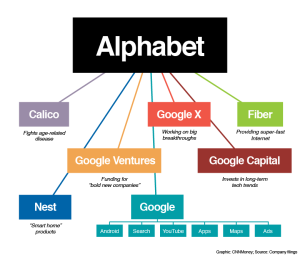 Google brand is being transitioned to a newly created brand called Alphabet, a reference to all of the companies within it being “the letters” in the greater structure.
Google brand is being transitioned to a newly created brand called Alphabet, a reference to all of the companies within it being “the letters” in the greater structure.
This change is coming for one big reason: the founders of Google, now CEO and President of Alphabet, understand the value of brand architecture. Read More...
Addison Whitney is a global branding firm with a passion for building strong brands.
To learn more about Addison Whitney, visit our website at AddisonWhitney.com, or contact us here.
Google's New Alphabet
Today's post comes from guest blogger John Lineberger, Brand Strategy Associate at Addison Whitney
Seventeen years ago the world was introduced to an internet search engine with a funny name.
Between then and now that search engine would become one of the largest companies in the world, spawning a number of household software names, a movie, and that funny name would change from a noun to a verb. Nowadays, what started as the most intuitive internet search engine to date has begun to execute on ideas previously seen only in The Jetsons and Star Trek—from self-driving cars and internet drones, to cancer-detecting bracelets and lifespan advancement technology.
This week, Google (which is, of course, the aforementioned company) announced that it will make another step forward. Google will still be Google, albeit a slimmed down version; but its former subsidiaries will become its brothers and sisters, and there for the first time, Google will be under the umbrella of another brand. The overarching parent role previously held by the Google brand is being transitioned to a newly created brand called Alphabet, a reference to all of the companies within it being “the letters” in the greater structure.
Former functions of the Google name such as Fiber, Google Ventures, and Calico will now be mentioned alongside the former master brand, rather than under it. Management teams and new CEOs will have direct control over these companies that used to be under the direct influence of Google. This change is coming for one big reason: the founders of Google, now CEO and President of Alphabet, understand the value of brand architecture.
Restructuring the portfolio may seem risky. We all know these subsidiaries of Google as exactly that—subsidiaries of Google. With such prominent brand awareness, what if cutting ties hurts the credibility of these products? What if some faith is lost in the efficacy of these companies as new executive teams are put in place and each has more autonomy? This is a move never seen before within the major market powers.
However, the benefits far outweigh the risks. Some still solely associate Google with its first innovation, the search engine. Over the years it has grown and evolved into so much more. The brand equity of every company in the Alphabet umbrella is strong. By making them independent under a holding company, their individual brands can only breathe and grow. The diversity of the companies sprouting under the Google name was such that it didn’t make sense to keep an automated drone company or a digital contact lens company tied up in the Google name. By allowing these companies room for separation, they are now able to grow into unique, effective brands independent of Google and its connotations.
In a more concrete sense, the move allows investors to see all of the different companies in a more disparate lens. Google will still be the largest and most profitable company in the Alphabet portfolio, but investors can now look and understand where revenue is coming from and recognize the fact that some of the newer companies will not be profitable for a few years. The move also allows for easier new company acquisition and spin-off.
Staying conscious of the architecture of one’s company can be crucial to its success. As with all aspects of branding, it can be an overlooked process in the course of a company’s development; and can be even more overlooked than such devices as naming, positioning and messaging due to its tendency to be a little less sexy. Initially, much of the coverage was centered on the name, and less so around the strategic decision. However, we see here how brand architecture can be a beneficial and proactive step.
And for those a little bit uncomfortable with seeing such a change from an old standby to this new Alphabet, just remember: G is for Google.
Image Source: https://money.cnn.com/2015/08/10/technology/alphabet-google/
Addison Whitney is a global branding firm with a passion for building strong brands.
To learn more about Addison Whitney, visit our website at AddisonWhitney.com, or contact us here.
Find Your Trench Coat: Branding Success and Focusing on What You Do Best
When Burberry appointed Angela Ahrendts, an American from the Midwest, as their CEO in 2006 many scoffed at the choice. With production facilities in different countries, no two shops with the same mix of merchandise, and trench coats that varied in price not just from country to country but from store to store, Burberry was in the midst of a brand crisis.
The diversified merchandise, much of it small, random goods such as hats, key chains, and even kilts made the brand not only less cohesive but much more accessible to a broad audience. Angela pointed out the brand’s main issue in an interview with Harvard Business Review when she said, “a luxury brand turned ubiquitous is anything but luxurious.” But while she had successfully identified the problem, many were worried that she wasn’t the right person to solve it.
They were wrong.
Ahrendts’ strategy was very simple: focus on trench coats. This may seem obvious, but it is a concept many brands fail to grasp.
A great brand usually begins with one thing it does very well. Louis Vuitton’s specialty is luggage. Christian Louboutin’s is shoes. Burberry’s had been the trench coat. However, often when a company achieves success, it begins to feel as if it can do anything and forgets what had made it so successful in the first place.
 Ahrendts wanted to reverse this trend and return to Burberry’s roots. When a brand’s strategy is to focus on what they do best, it creates an instant framework for each subsequent decision made about the brand. In addition to this, basing a rebrand or a marketing campaign on an attribute of the brand that has already been proven successful, desirable, or iconic leaves less room for potential disaster. Finally, a singular focus, especially one that harkens back to the roots of a company, clarifies the brand for consumers, and a clear, intelligible brand is always more desirable to the customer.
Ahrendts wanted to reverse this trend and return to Burberry’s roots. When a brand’s strategy is to focus on what they do best, it creates an instant framework for each subsequent decision made about the brand. In addition to this, basing a rebrand or a marketing campaign on an attribute of the brand that has already been proven successful, desirable, or iconic leaves less room for potential disaster. Finally, a singular focus, especially one that harkens back to the roots of a company, clarifies the brand for consumers, and a clear, intelligible brand is always more desirable to the customer.
Burberry was able to return to their original brand position of premium outerwear supplier by making sure each strategic move of the company, whether it be in supply chain management, design, advertising, or social media was primarily focused on the trench coat. Burberry launched a social media movement promoting their new website, www.ArtOfTheTrench.com, which not only featured the many new styles of trench coat they had available but a look at the elite history that surrounded this most prestigious of coats.
As a result, they were the first luxury brand to reach ten million likes on Facebook. Burberry then chose Emma Watson as the face of its new advertising campaign. Emma Watson, authentically English yet still relevant internationally, wore a trench coat in every ad.
Since this massive overhaul, Burberry was named by Interbrand as the fastest growing brand and no longer will you see every person (and their dog) walking down the street in a random assortment of brown checkered products. Burberry is once more a luxury, and it should be a lesson to the many once-luxury brands that seem to be slipping down the path to overdiversifiction and ubiquity.
Every company needs to find their own trench coat and stick to it.
Image Source:
https://my.asiatatler.com/fashion-beauty/fashion/100-years-of-burberry-trench-coats-world-war-i-casablanca-art-of-the-trench
Addison Whitney is a global branding firm with a passion for building strong brands.
To learn more about Addison Whitney, visit our website at AddisonWhitney.com, or contact us here.

